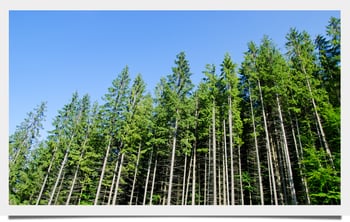3 min read
iTimber: Apple Partners with The Conservation Fund to Manage Working Forests
John Greene
:
April 27, 2015
Earlier this month, The Conservation Fund (CF) announced its partnership with global technology giant Apple, Inc. (NASDAQ: AAPL) in the acquisition of 36,000 acres of timberland in the Eastern US. Managed through CF subsidiary The Working Forest Fund (WFF), the newly-acquired land includes 32,400 acres within Maine’s Reed Forest, as well as 3,600 acres in southeastern North Carolina’s Brunswick Forest. While WFF is responsible for acquiring and managing over 400,000 acres of forestlands in 13 states since its inception in 1998, this latest partnership serves to highlight the increasing need for reasonable environmental stewardship at a corporate level and, most importantly, broader consumer education of sustainable forestry practices.
For its part, WFF has a new, high-profile partner with very deep pockets to aid in its endeavor to protect US forestlands. While WFF is indeed in the business of land conservation, its objectives and, by extension, its methodologies, differ substantially from many other non-profits and NGOs engaged in resource protection and management. As WFF states via its website, “Our goal is to ensure forests' vital role in providing clean air and water, wildlife habitat, and economic benefits for communities across America.”
 The important distinction in this case is that WFF understands the ecological and economic importance of maintaining working forests. The organization adds, “We offer a dedicated source of bridge capital, and for each property, we develop and implement sustainable forest management plans, and place conservation safeguards. We then return the forestland to private ownership or public agency stewardship, so that each property remains a protected working forest, boosting its local economy by maintaining jobs.” With an ownership and management structure that recognizes the importance of maintaining working forests, this arrangement should benefit the forest products industries and local economies in ME and NC.
The important distinction in this case is that WFF understands the ecological and economic importance of maintaining working forests. The organization adds, “We offer a dedicated source of bridge capital, and for each property, we develop and implement sustainable forest management plans, and place conservation safeguards. We then return the forestland to private ownership or public agency stewardship, so that each property remains a protected working forest, boosting its local economy by maintaining jobs.” With an ownership and management structure that recognizes the importance of maintaining working forests, this arrangement should benefit the forest products industries and local economies in ME and NC.
Enter Apple
Ever the visionaries, Apple mastered the art of creating brand evangelists long before it became a corporate catchphrase. While Apple has been popular with graphic designers and journalists for decades, the company has really only been a household name since it changed the way we listen to music with the introduction of the iPod in 2001. Since then, Apple enthusiasts—some of the most loyal consumers in the world— have increased exponentially, which, given the WFF partnership, provides an incredible opportunity for forest-industry exposure and consumer education on an enormous scale.
As environmental sustainability continues to make headlines, Apple is leading by example by demonstrating that it can generate revenue while maintaining sound environmental stewardship policies. With Q12015 revenue of $74.6 billion (yes, billion with a “b”) the tech giant understands that long-term profits can—and oftentimes must—be bolstered by lasting resource management policies. If you have ever owned an Apple product, you know the company’s penchant for substantive design, which extends to its distinctive product presentation and packaging. Can you imagine the sheer volume of paper and fiber that Apple utilizes in a single year on a global basis just to keep that packaging fresh and appealing?
To give you some idea of what that number looks like, Lisa Jackson, Apple’s vice president of Environmental Initiatives, quantified the company’s paper use in relation to the 36,000 newly-acquired acres via the WFF: “The collective annual production of paper fiber from these two forests is equivalent to nearly half of the virgin fiber that went into iPhone, iPad, iPod, Mac, and Apple TV packaging last year.” That’s a whole lot of paper.
Most importantly for the forest products industry, Jackson stated, “Apple believes that paper, like energy, can be a renewable resource. So Apple is striving to supply 100 percent of the virgin fibers used in its paper and packaging from sustainably managed forests or controlled wood sources.” As advocates for the forest products industry and sound forestry management/practices, the importance of this proclamation cannot be overstated… so I’ll repeat it: “Apple believes that paper, like energy, can be a renewable resource.”
Just imagine the educational opportunities that arise from the above statement: forestry facts and figures, sustainability practices, mill processes and resource management, renewable energy markets, etc. Through its partnership with The Conservation Fund, Apple is boldly starting a new conversation that excludes the tired, ecological-alarmist talking points and instead focuses on sensible economic and environmental solutions for the future. The larger forestry and forest products industries should support this partnership and, most importantly, use the opportunity to join the conversation and provide tangible education in an area that has otherwise been dominated by misinformation.





